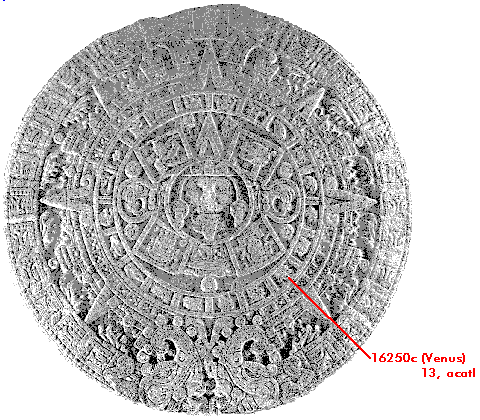THE RING OF FLAMES
Part Five
 |
With this example, one may observe how different rings, in relation to their constant numbers and the event numbers of the different reckoning systems, may acquire and reflect distinct meanings, depending upon how they are precisely related.
Obviously, the numbers of the different reckoning systems may be calculated in distinct manners. But, what is significant concerns how these distinct calculations reveal certain features designed into the calendar's different visual elements. Again, for the 16250 event-number to fall precisely on the midsection of the 13th day- glyph, acatl, can only be considered a feat of design. To assign it to mere coincidence would seem extreme to us.
Time and again, then, we see that the same elements in ancient artwork may enjoy distinct meanings. Such would seem to reflect the wealth of imagination that the ancient astronomers, in this case, achieved in assigning so much scientific information to such a limited visual space in their artwork.
Observations
In this essay, we have attempted to offer another example of calculating specific relationships regarding the constant numbers shown on the Aztec Calendar, and the cycle numbers of the different reckoning systems known to have existed within ancient Mesoamerica.
By assigning the 52-year cycle value to each one of the symbols representing a flame on the Ring of Flames of the Aztec Calendar, we have seen how one may be able to calculate the number of complete calendars that would go into representing the Sun's Great Cycle of 26000 years (365c). The complete number of Aztec Calendars that would represent the 26000-year cycle would be 41.6 calendars. And that particular cut-off line would fall just prior to the 13 acatl day-glyph.
If this assignment of values is valid, then possibly the ancient astronomers marked off the point in time, at a future date, when the 26000-year cycle would end and begin again. Such a possibility, then, would not only represent the fact that they knew of the 26000-year cycle, but even knew when it initiated a new era, a starting point as it were. Such knowledge would be equivalent to our knowing when a new year begins on the 365c; only here it would correspond to a 26000 year-count.
The coincidence of constant numbers and cycle numbers, in relation to the calculation of values and specific periods of time and the cycles of time, does not appear to be a coincidence at all. And all of this coupled with an even more intriguing coincidence with regard to the marking off of 13 acatl on the day-glyph ring would surely support the case that such an event is due to design. To have designed the spatial division within the Aztec Calendar along these lines out of pure happenstance would probably represent such an improbability as to be all but unbelievable.
To understand that the ancient astronomers were working with a detailed knowledge of the cosmos, or the Universe, is but to comprehend the significance of science in ancient artwork. In other words, it is easier for this author to imagine that they designed these relationships, rather than to think that they happened upon them by accident.
The analysis of the Ring of Flames, in these terms, might reflect then the precession of the equinoxes in very exact terms. For, if one examines the flames themselves in the sculpture, one can see that they do not obey a symmetrical space allotment with respect to the Ring of Serpents, but seem to march along the backs of the serpents in a progressive manner. It is this relationship that we shall examine in the following essay on the Ring of Serpents.
Part Six